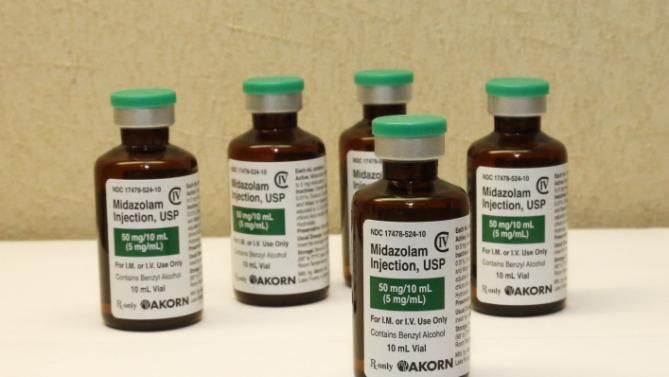
The U.S. Supreme Court has ruled that the drug Midazolam is constitutional, ruling against three death row inmates who sought to ban the use of the drug saying it caused “excruciating pain”.
The controversial ruling saw split opinion among members of the court, with Justices Stephen G. Breyer and Ruth Bader Ginsburg almost ruling that the death penalty itself was unconstitutional.
A 5-to-4 decision was eventually reached on allowing for the drug to be used in executions, with the majority saying that the inmates had failed to come up with any preferable alternative execution methods, or show evidence that Midazolam caused severe pain.

BYPASS THE CENSORS
Sign up to get unfiltered news delivered straight to your inbox.
You can unsubscribe any time. By subscribing you agree to our Terms of Use
Nytimes.com reports:
The drug, the sedative midazolam, played a part in three long and apparently painful executions last year. It was used in an effort to render inmates unconscious before they were injected with other drugs that cause severe pain.
In dissent, Justice Sonia Sotomayor, who joined the other three members of the court’s liberal wing, said, “The court’s available-alternative requirement leads to patently absurd consequences.”
“Petitioners contend that Oklahoma’s current protocol is a barbarous method of punishment — the chemical equivalent of being burned alive,” Justice Sotomayor wrote. “But under the court’s new rule, it would not matter whether the state intended to use midazolam, or instead to have petitioners drawn and quartered, slowly tortured to death or actually burned at the stake.”
Justices Breyer, Ginsburg and Elena Kagan joined Justice Sotomayor’s dissent.
In a second, more sweeping dissent, Justice Breyer, joined by Justice Ginsburg, said it was time to consider a larger issue.
“Rather than try to patch up the death penalty’s legal wounds one at a time,” Justice Breyer wrote, “I would ask for full briefing on a more basic question: whether the death penalty violates the Constitution.”
In a 46-page dissent that included charts and maps, he said “it is highly likely that the death penalty violates the Eighth Amendment,” which bars cruel and unusual punishments. He said there was evidence that innocent people have been executed, that death row exonerations were frequent, that death sentences were imposed arbitrarily and that the capital justice system was warped by racial discrimination and politics.
Justice Breyer added that there was scant reason to think that the death penalty deterred crime and that long delays between death sentences and executions might themselves violate the Eighth Amendment. He noted that most of the country did not use the death penalty and that the United States was an international outlier in embracing it.
Justice Scalia responded to what he called “Justice Breyer’s plea for judicial abolition of the death penalty” by calling it “gobbledy gook.” The punishment is contemplated by the Constitution, Justice Scalia said, and disingenuously opposed on grounds created by its opponents.
Criticizing the death penalty on the ground that it is not implemented fast enough, for instance, Justice Scalia said, “calls to mind the man sentenced to death for killing his parents, who pleads for mercy on the ground that he is an orphan.”
“We federal judges,” Justice Scalia continued, “live in a world apart from the vast majority of Americans. After work, we retire to homes in placid suburbia or to high-rise co-ops with guards at the door. We are not confronted with the threat of violence that is ever present in many Americans’ everyday lives. The suggestion that the incremental deterrent effect of capital punishment does not seem ‘significant’ reflects, it seems to me, a let-them-eat-cake obliviousness to the needs of others. Let the people decide how much incremental deterrence is appropriate.”
In a second concurrence, Justice Thomas described several cases in which the Supreme Court had spared the lives of killers.
“Whatever one’s views on the permissibility or wisdom of the death penalty,” Justice Thomas wrote, “I doubt anyone would disagree that each of these crimes was egregious enough to merit the severest condemnation that society has to offer. The only constitutional problem with the fact that these criminals were spared that condemnation, while others were not, is that their amnesty came in the form of unfounded claims. Arbitrariness has nothing to do with it.”
The challenge to the execution drug was brought by four condemned inmates in Oklahoma, who said it did not reliably render the person unconscious and so violated the Eighth Amendment. Lower courts disagreed.
Oklahoma and several other states started to use midazolam in executions after manufacturers in Europe and the United States refused to sell them the barbiturates that were traditionally used to produce unconsciousness.
Justice Alito suggested that condemned inmates should not benefit from the shortages, saying that “anti-death-penalty advocates pressured pharmaceutical companies to refuse to supply the drugs used to carry out death sentences.”
“The execution protocols states hurriedly devise as they scramble to locate new and untested drugs,” she wrote, “are all the more likely to be cruel and unusual — presumably, these drugs would have been the states’ first choice were they in fact more effective.”
Lawyers for the Oklahoma inmates, with the support of experts in pharmacology and anesthetics, said midazolam, even if properly administered, was unreliable. They pointed to three executions last year that seemed to go awry.
In April 2014, Clayton D. Lockett regained consciousness during the execution procedure, writhing and moaning after the intravenous line was improperly placed. In Ohio in January 2014 and in Arizona in July, prisoners appeared to gasp and choke for extended periods.
The Supreme Court last considered lethal injections in 2008, in Baze v. Rees, when it held that what was then the standard three-drug combination, using the barbiturate sodium thiopental as the first agent, did not violate the Eighth Amendment.
The new case, Glossip v. Gross, No. 14-7955, originally included a fourth inmate, Charles F. Warner. But he was executed on Jan. 15 after the Supreme Court denied his request for a stay by a 5-to-4 vote.
A little more than a week later, the court agreed to hear the remaining inmates’ appeals, and a few days after that it stayed their executions.
They are Richard E. Glossip, who was convicted of arranging the beating death of his employer; John M. Grant, who was convicted of stabbing a prison cafeteria worker to death; and Benjamin R. Cole Sr., who was convicted of breaking his 9-month-old daughter’s spine, killing her.
“While most humans wish to die a painless death,” Justice Alito wrote for the majority, “many do not have that good fortune. Holding that the Eighth Amendment demands the elimination of essentially all risk of pain would effectively outlaw the death penalty altogether.”


